
日曜日の朝早く、駅の近くの公園で、お年寄りの方達が一緒にラジオ体操をしています。
In the very early morning on a Sunday, these seniors are enjoying the local park for exercise and community.

寒いときに、新宿御苑の新しい温室を勧めます。温室のなかで、熱帯の植物を楽しみながら、外の東京の風景を楽しめます。全部ガラス張りなので、外側に反射している風景もすてきです。
The best place to escape Tokyo’s winter is inside the new greenhouse in Shinjuku Gyoen. I love exploring all the tropical plants, and seeing the fall and winter park landscapes through the glass walls. From the outside, the building reflects the giant trees and clouds.

東京湾のあたりは50年前に、高速道路と公園のようなインフラをたくさん作りました。全く使われていない不毛の空間ときれいな場所が同時に存在しています。雑草と偶然にできた緑の空間が生き残ります。
I often show images of the long cherry tree path that leads from Tatsumi’s subway to the municipal swimming pool. The 10 minute walk mixes all that’s both beautiful and dirty about 1960s infrastructure projects. There’s the amazing public sports facility, a now mature park with tall trees bordering the elevated freeway, and an odd mix of new construction, prior buildings, and informal green spaces that benefit from a lack of attention.


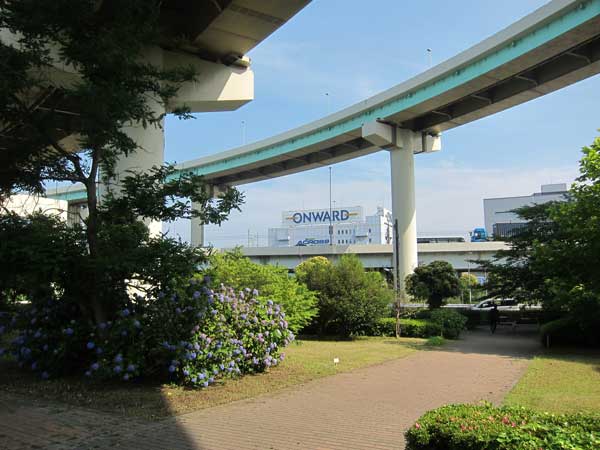
Leaving the Tatsumi Metro station, I cross over one highway on a pedestrian bridge, while passing below several elevated highways intersecting with flyovers.
This Onward sign on top of a warehouse feels like a personal extortion to move through this jumble of smog and burning fuels. Onward also seems to capture this part of Tokyo’s role as a place of distribution by ship and tractor trailer. In this frenzy of “logistics,” I always wonder what’s being transported and to whom.
Fortunately, the trees planted decades ago muffle the noise somewhat, and part of this marginal land is used as a park, community vegetable garden, and Olympic level swimming pool.

ニューヨークのハイラインという新しい公園もセントラルパークも象徴的な公共空間です。自然と都市の関係がうまくできていて、気分がいいです。1934年から1980年まで使われていた電車の高架線路を公園にしたのが、ハイラインです。
On a recent trip to New York City, I took my film camera to some iconic parks. Above is the reservoir in Central Park, a place for exercise, leisure, and path between Upper East Side and Upper West Side.
Below is the High Line, a more recent park created from a dis-used elevated train line west of Chelsea. I love how in both environments, you can enjoy nature and feel connected to an urban landscape.

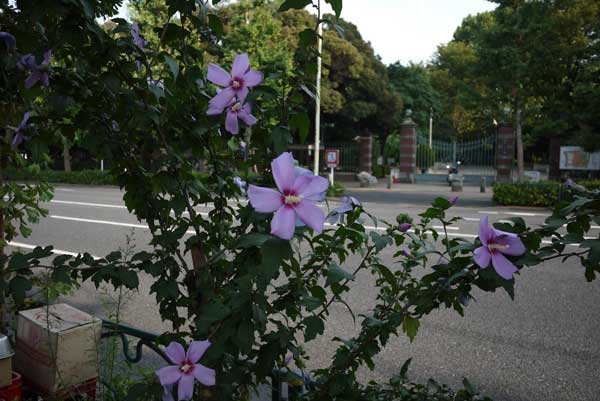
8月はあまり花が咲きません。多分、暑すぎるからです。けれども、東京の歩道で、ムクゲは育ちやすいです。明るい色と江戸文化との関係に興味があります。
August has more foliage than flowers, and it seems that few can bear the unrelenting heat. That’s what’s so wonderful about “Mukuge” (ムクゲ) a Japanese hibiscus that grows easily on Tokyo city sidewalks. I like the wild colors that make the city more spectacular, and Mukuge forms part of the Aoi (アオイ)family of flowers associated with the Edo shogunate.
Photo of Omeikaido Dori sidewalk, across from Sanshinomori Park in Higashi Koenji 蚕糸の森 公園、東高円寺。A small sign says that it was planted in March, 2010 with support from KDDI.

Spotted in Harajuku, this pink scooter parked next to red azaleas. I am overwhelmed by the extravagance of this product juxtaposed with nature in full bloom, and, of course, the color combination. For all those foreigners who think that Japanese culture is full of restraint and minimalism, this image shows the other side. This mix of nature and industrial product reminds me of the psychedelic backdrops to the ubiquitous television variety shows full of shiny objects, moving parts, and more colors than the rainbow.

井ノ頭公園が花見を中止するというのは、本当でしょうか。先が見えないので、みんなが不安で落ち着かないようです。
My friend Matt sent me this intricate sakura weather map: it shows the updated forecast for the start of cherry blossoms across the Japanese archipelago. Even if you can’t read Japanese, it’s impressive to see how much weather forecasting amplifies cherry blossom season.
Today I also heard from Twitter’s @Matt_Alt that there are big signs at Inokashira park Big asking visitors to refrain from holding cherry blossom viewing parties there. This is one of Tokyo’s most famous parks, and one of the most popular places for young people to celebrate spring with all night and all day drinking parties.
It’s now just over two weeks after the horrific natural and man-made disaster that began with the East Japan great earthquake. With looming energy shortages, national mourning for the dead, and continued fears about nuclear fallout, Tokyo life will not be the same. Yet it is still impossible to fully know what will emerge in the coming months and years.
Will these events increase or reverse Japan’s hyper-urbanization? How will people respond to new concerns about food and water safety? Can the government and industry regain trust and provide leadership? How can civil society contribute to rebuilding the country and restoring Japan’s international reputation?
And can public spaces and local businesses flourish in a time of anxiety and uncertainty?
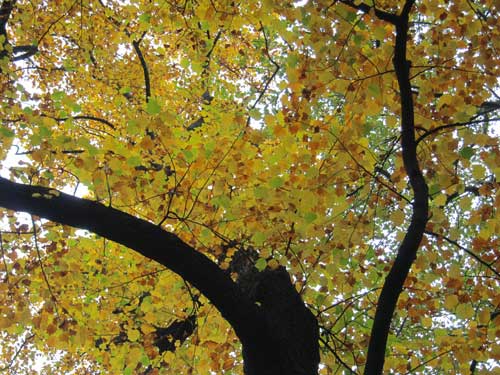
Fall foliage in Tokyo is spectacular. I took these two images on a Sunday walk: the one above in Shinjuku Gyoen, the one below on the boulevard near Sendagaya JR station. I wish Tokyo had more mature trees.
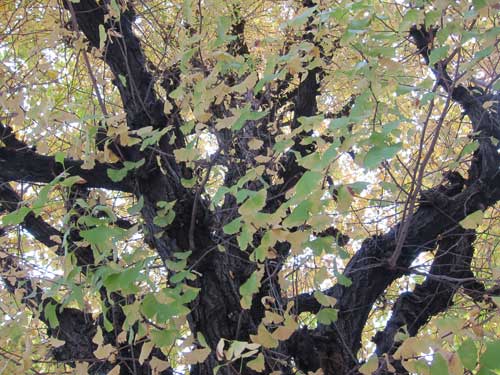

On my Meguro walk, I noticed two pocket parks, one newer and one older. Both have a similar plan: wide open space with gravel, and minimal plants, play areas, and seating. I know that one reason Tokyo parks are created this way is to provide a gathering space for emergencies. Yet if emergencies are an every 10, 20 or even 50 year experience, wouldn’t it make more sense to get better use out of the parks in the meantime? In an emergency the plants could be justifiably trampled, but at least they would provide more active natural environments for daily life.
During my weekday visit, I noticed two office guys taking a smoking break (separately), a senior taking a rest, and some high school kids on their cellphones. It would be great if there was also room for vegetable growing, butterfly gardens, bird watchers, and wildlife habitat.



Roppongi is a very foreign neighborhood for me since I rarely visit its offices, nightclubs and museums. However, with the recent conference, I took a friend along a back street between mega developments Mid Town and Roppongi Hills. We stumbled a very charming, small park named Roppongi West Park (六本木西公園). It was a welcome escape from the elevated freeways and concrete overload.
The park provides a great amount of shade and the loud murmur of cicadas. My fellow Maryland state friend and I wondered how come mid-Atlantic cicadas only appear every seven years, while Japanese ones go through similar seven year cycles but appear annually. The park had benches with businessmen smoking, chatting, using their cellphones, and escaping their offices. There were also sand box, playground, and a public bathroom.

Seeing this small gem made me think about the up-until-now unrealized possibilities for the mega developers to connect with their neighborhoods through landscapes. Mori Building talks about how its vertical gardens lower summer time temperature in its neighborhoods. And Mitsubishi Estate is concerned with making Marunouchi more attractive through livable streets.
Creating gardens and habitats that extend to nearby pocket parks, as well as neighboring residential and commercial gardens, could brand these new places with historical memory, a signature fruit tree, butterfly or bird habitat, outdoor recreation, and innovative public place making. While the developers goal is to maximize rental income, attention to the neighborhood, its existing assets and people, could be a low-cost and high impact way to brand, differentiate, and attract visitors and tenants.
District landscaping is one of the most economical and transformative improvements. By extending beyond the limits of a single property or the holdings of one developer, district landscaping is vital to place-making, memory, habitat, and human affection.

I love this giant hedge framing a modern house in Nakano. It’s even more beautiful at night, which is when we discovered it on a walk through the neighborhood.
The house is mostly concrete with wood on the second floor balconies and some bamboo as a screen for the ground floor. I love how the hedge opens up to provide an entrance to the house (and a permeable parking space). The outer hedge is then echoed by a shorter inner hedge close to the ground floor windows. On the right side, there’s a small gap and room to park a few bicycles. It’s a great combination of privacy and opening, concrete structure and plant life.

I like how the gardener has used bamboo poles to train the hedge into an arch over the entrance. It’s a simple and elegant support.

Viewed from the side, the house disappears behind the thick greenery. Usually I am a fan of much greater plant variety, but this residential garden shows how much can be achieved with a single species.
Thanks to the 30 people who participated in the Tokyo DIY Gardening workshop last night at 3331 Arts Chiyoda. We created an enormous collage map and shared interesting stories and images of Tokyo’s wonderful green spaces, existing and imagined. A big thanks to Chris Berthelsen for conceiving, preparing and motivating this participatory project. We’ll digitize the 4 meter by 2 meter map and post about it soon.
This post is about park signage, with images of hand-drawn and printed signs outside the 3331 Arts Chiyoda park. Alongside a lawn and some shade trees, the front park includes a rose garden with several varieties. I found it interesting that the map of the rose types was so ad hoc and temporary: written on paper and affixed with metal clips.

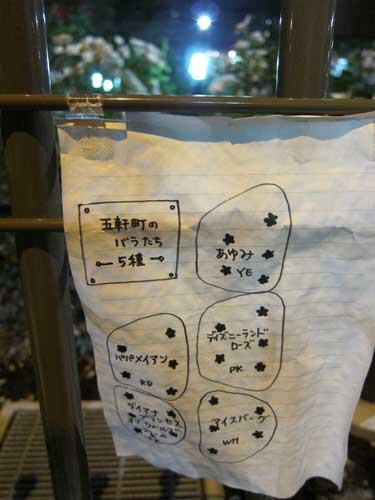
This very informal sign contrasts with a more typical sign found in Tokyo parks. Using child-like manga, the sign details the many forbidden activities.
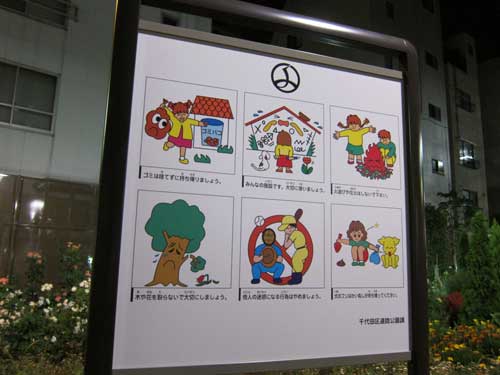
Perhaps the most interesting warning is 「他人の迷惑になる行為はやめましょう」。Let’s not do anything that will disturb other people, below an image of baseball players. I am struck by how the image is so specific and the warning is so open to any interpretation. It invites the reader to imagine just how many possible actions could bother other people.
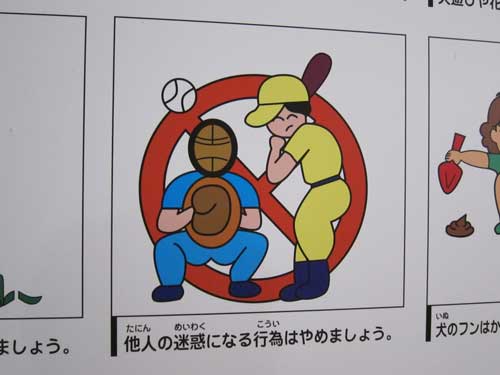
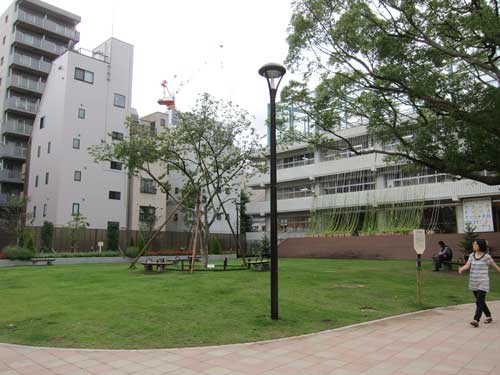
A reminder that tomorrow night is the Tokyo DIY Gardening Workshop at 3331 Arts Chiyoda, a great new arts space in a converted junior high school. I took these photos last week when I went there for a planning meeting with my workshop co-organizer Chris Berthelsen of Fixes. It’s great that in addition to all the art exhibit, gallery and office spaces inside, the front of the 3331 Arts Chiyoda is a very welcoming park with a lawn and shade trees (plus a very popular smoking area next to a public bathroom).

For non-Japanese and non-parents, it’s a great experience to see the inside and even the roof of what seems like a typical city school: old wood shoe lockers, simple yet sturdy furniture, and rooms that seem very Bauhaus in their streamlined functionality. The roof is also interesting because for city schools that is probably where most if not all recreation takes place. For some reason the art space created this small lawn area, and of course I followed Chris’ lead in taking off my sandals and walking bare-foot on the grass.

3331 Arts Chiyoda has also set up dozens of rental plots for people who want to grow vegetables. If anyone is nearby, there seem to be plenty of vacant spaces, and it would be a cool place to grow vegetables and to get to know the arts groups and activities in the building.
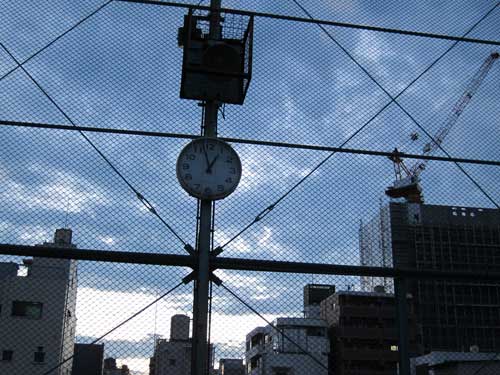
The chain link fence on the sides and top, the institutional clock, even the caged loudspeakers evoke an ordinary childhood scene that is unfamiliar to me. It’s cool to experience these spaces, and imagine that many of the people I know in Tokyo attended schools like this.